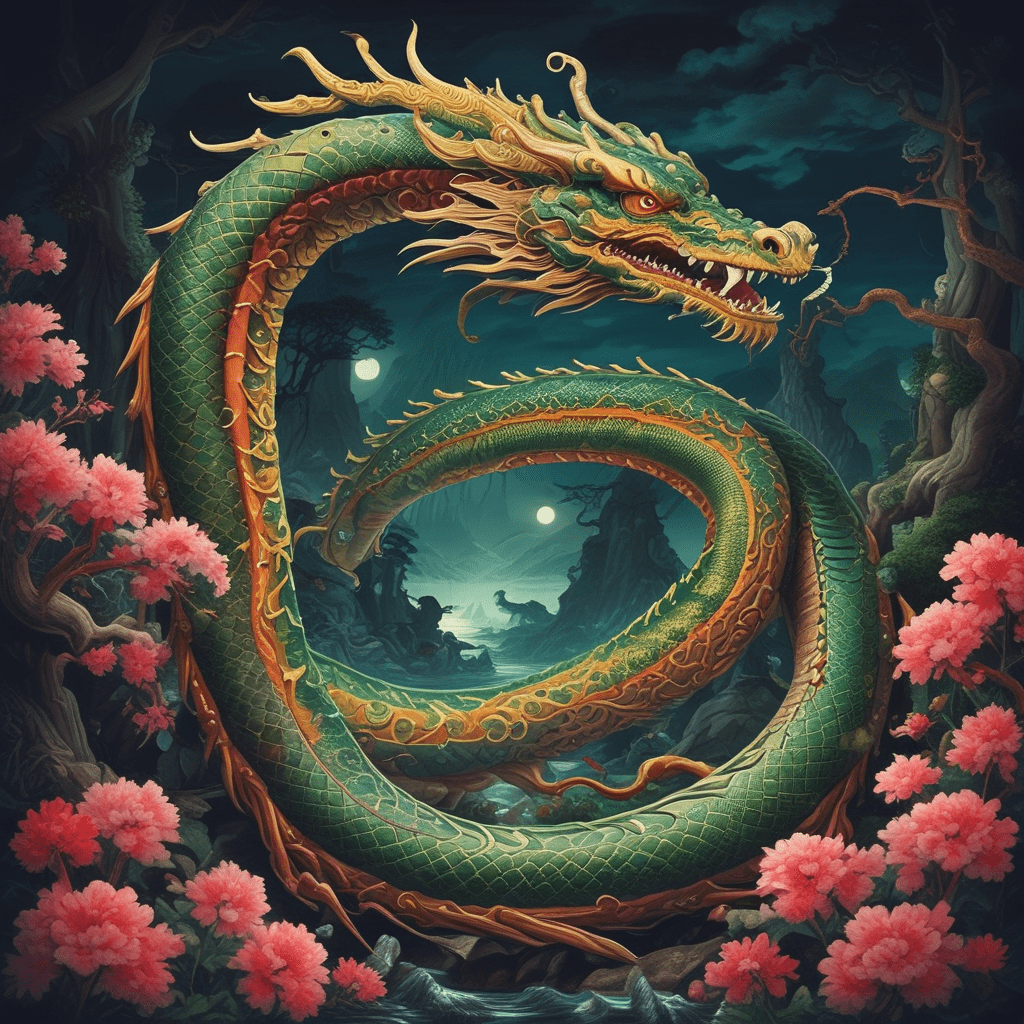The Myth of the Eight-Forked Serpent: Yamata no Orochi in Japanese Folklore
Introduction to Yamata no Orochi
Yamata no Orochi, also known as the Eight-Forked Serpent, is a legendary creature from Japanese mythology. This massive serpent plays a significant role in one of Japan’s most popular myths involving the storm god Susanoo and the maiden Kushinada-hime.
According to the myth, Yamata no Orochi had eight heads and eight tails, with eyes as red as winter cherries. The beast’s enormous size made it a fearsome creature that terrorized the land, demanding human sacrifices in exchange for not causing destruction.
The Tale of Susanoo and Yamata no Orochi
The legend of Yamata no Orochi begins with Susanoo, the Shinto god of the sea and storms. Banished from the heavens for his disruptive behavior, Susanoo came across an elderly couple grieving over their daughter’s impending sacrifice to the serpent. Moved by their plight, Susanoo offered to help rid them of Yamata no Orochi in exchange for the maiden’s hand in marriage.
Intrigued by Susanoo’s bold proposal, the couple agreed, and together they devised a plan to defeat the serpent. Susanoo transformed Kushinada-hime into a comb (kushi) and instructed her parents to brew a special sake (rice wine) in eight large vats. When Yamata no Orochi approached, drawn by the sake’s scent, it consumed the rice wine from each container.
Intoxicated by the potent drink, the serpent grew vulnerable, and Susanoo seized the opportunity to slay the creature. Drawing his sword, he attacked and beheaded each of Orochi’s eight heads, eventually discovering a legendary sword within one of them, known as Kusanagi-no-Tsurugi (Grass-Cutting Sword).
The Symbolism of the Myth
The tale of Susanoo and Yamata no Orochi carries deep symbolic significance in Japanese folklore. The defeat of the eight-headed serpent is often interpreted as the triumph of bravery, cunning, and heroism over overwhelming adversity. Susanoo’s actions not only save Kushinada-hime from a tragic fate but also deliver the local community from the terror of Yamata no Orochi’s reign of fear.
Yamata no Orochi’s defeat further highlights the themes of loyalty, sacrifice, and the strength of familial bonds featured prominently in Japanese mythology. The tale underscores the importance of cooperation and resourcefulness in overcoming formidable challenges, as exemplified by Susanoo’s clever strategy and intervention to protect the innocent.
Legacy and Cultural Significance
The legend of Yamata no Orochi continues to captivate audiences worldwide, resonating beyond its mythological origins. The tale has inspired various artistic interpretations in literature, theater, and visual arts, demonstrating its enduring appeal and relevance in contemporary culture.
As a symbol of resilience and the human capacity to confront and overcome adversity, the myth of Yamata no Orochi remains a timeless narrative that reflects universal themes of courage, redemption, and the enduring power of hope amidst daunting obstacles.
In conclusion, the myth of the Eight-Forked Serpent: Yamata no Orochi is a rich and enduring tale that continues to enchant and inspire audiences with its timeless themes of bravery, heroism, and the triumph of good over evil.
FAQ about The Myth of the Eight-Forked Serpent: Yamata no Orochi
What is Yamata no Orochi in Japanese Folklore?
Yamata no Orochi, also known as the Eight-Forked Serpent, is a legendary creature from Japanese mythology. It is a massive serpent with eight heads and eight tails.
Who is Susanoo and his connection to Yamata no Orochi?
Susanoo, a powerful Shinto deity, encountered the Yamata no Orochi during his exile. In the myth, Susanoo slays the serpent as part of a deal with the god of the earth, Izanagi, to marry his daughter, Kushinada-hime.
What significance does the slaying of Yamata no Orochi have in Japanese folklore?
The slaying of Yamata no Orochi by Susanoo is a pivotal myth in Japanese folklore. It symbolizes the triumph of good over evil, bravery, and the fulfillment of divine tasks.
Is Yamata no Orochi a popular symbol in Japanese culture?
Yes, Yamata no Orochi remains a prominent symbol in Japanese culture, appearing in various forms of media, art, and popular culture as a legendary and fearsome serpent.



